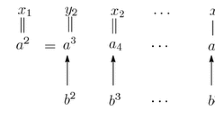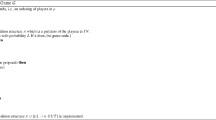Abstract
An intertemporal voting model is examined where, at each date, there is a pairwise majority vote between the existing chosen state and some other state, chosen randomly. Intertemporal voting simplifies the strategic issues and the agenda setting is as unrestricted as possible. Voters adopt Markov strategies. The possibility of cycles is examined, both in the intertemporal extension to the Condorcet paradox and in more general examples. The set of possibilities is rich, as is demonstrated by an exhaustive study of a three-person, three-state world. Equilibrium in pure strategies may fail to exist but a weakening of the equilibrium concept to admit probabilistic voting allows a general existence result to be proved. The analysis leads to the development of a dominant state which extends the notion of a Condorcet winner.
Similar content being viewed by others
References
Arrow KJ (1963) Social choice and individual values, (2nd edn). Yale University Press, New Haven
Austen-Smith D (1987) Sophisticated sincerity: voting over endogenous agenda. Am Polit Sci Rev 81:1323–1330
Austen-Smith D, Banks J (1999) Cycling of simple rules in the spatial model. Soc Choice Welf 16:663–672
Banks J (1985) Sophisticated voting outcomes and agenda control. Soc Choice Welf 1:295–306
Banks J, Duggan J (2002) A multidimensional model of repeated elections. University of Rochester (unpublished)
Baron D (1996) A dynamic theory of collective goods programs. Am Polit Sci Rev 90:316–330
Bernheim BD, Nataraj S (2004) A solution concept for majority rule in dynamic settings. Stanford Univerity (unpublished)
Bernheim BD, Rangel A, Rayo L (2006) The power of the last word in legislative policy making. Econometrica 74:1161–1190
Condorcet M (1785) Essai sur l’application de l’analyse à la probabilitié des décisions rendues à la pluralité des voix. Paris
Farquharson R (1969) Theory of voting. Basil Blackwell, Oxford
Fudenberg D, Tirole J (1991) Game theory. MIT, Cambridge
Inada K (1969) On the simple majority decision rule. Econometrica 37:490–506
Kalandrakis A (2004) A three-player dynamic majoritarian bargaining game. J Econ Theory 116:294–332
Penn EM (2006) A model of farsighted voting. Harvard University (unpublished)
Author information
Authors and Affiliations
Corresponding author
Rights and permissions
About this article
Cite this article
Roberts, K. Condorcet cycles? A model of intertemporal voting. Soc Choice Welfare 29, 383–404 (2007). https://doi.org/10.1007/s00355-006-0211-2
Received:
Accepted:
Published:
Issue Date:
DOI: https://doi.org/10.1007/s00355-006-0211-2




